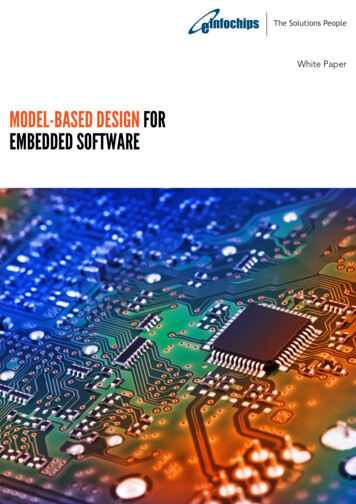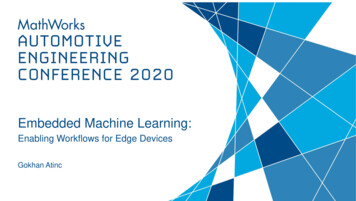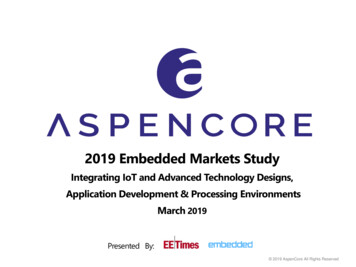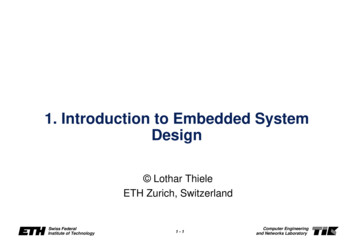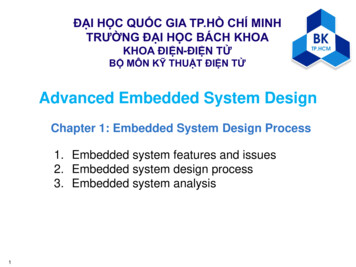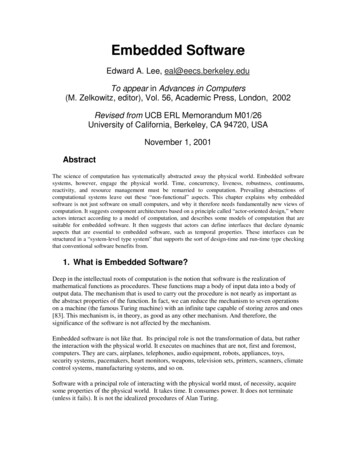
Transcription
Embedded SoftwareEdward A. Lee, eal@eecs.berkeley.eduTo appear in Advances in Computers(M. Zelkowitz, editor), Vol. 56, Academic Press, London, 2002Revised from UCB ERL Memorandum M01/26University of California, Berkeley, CA 94720, USANovember 1, 2001AbstractThe science of computation has systematically abstracted away the physical world. Embedded softwaresystems, however, engage the physical world. Time, concurrency, liveness, robustness, continuums,reactivity, and resource management must be remarried to computation. Prevailing abstractions ofcomputational systems leave out these “non-functional” aspects. This chapter explains why embeddedsoftware is not just software on small computers, and why it therefore needs fundamentally new views ofcomputation. It suggests component architectures based on a principle called “actor-oriented design,” whereactors interact according to a model of computation, and describes some models of computation that aresuitable for embedded software. It then suggests that actors can define interfaces that declare dynamicaspects that are essential to embedded software, such as temporal properties. These interfaces can bestructured in a “system-level type system” that supports the sort of design-time and run-time type checkingthat conventional software benefits from.1. What is Embedded Software?Deep in the intellectual roots of computation is the notion that software is the realization ofmathematical functions as procedures. These functions map a body of input data into a body ofoutput data. The mechanism that is used to carry out the procedure is not nearly as important asthe abstract properties of the function. In fact, we can reduce the mechanism to seven operationson a machine (the famous Turing machine) with an infinite tape capable of storing zeros and ones[83]. This mechanism is, in theory, as good as any other mechanism. And therefore, thesignificance of the software is not affected by the mechanism.Embedded software is not like that. Its principal role is not the transformation of data, but ratherthe interaction with the physical world. It executes on machines that are not, first and foremost,computers. They are cars, airplanes, telephones, audio equipment, robots, appliances, toys,security systems, pacemakers, heart monitors, weapons, television sets, printers, scanners, climatecontrol systems, manufacturing systems, and so on.Software with a principal role of interacting with the physical world must, of necessity, acquiresome properties of the physical world. It takes time. It consumes power. It does not terminate(unless it fails). It is not the idealized procedures of Alan Turing.
Computer science has tended to view this physicality of embedded software as messy.Consequently, design of embedded software has not benefited from the richly developedabstractions of the twentieth century. Instead of using object modeling, polymorphic typesystems, and automated memory management, engineers write assembly code for idiosyncraticdigital signal processors (DSPs) that can do finite impulse response filtering in one(deterministic) instruction cycle per tap.The engineers that write embedded software are rarely computer scientists. They are experts inthe application domain with a good understanding of the target architectures they work with. Thisis probably appropriate. The principal role of embedded software is interaction with the physicalworld. Consequently, the designer of that software should be the person who best understandsthat physical world. The challenge to computer scientists, should they choose to accept it, is toinvent better abstractions for that domain expert to do her job.Today’s domain experts may resist such help. In fact, their skepticism is well warranted. They seeJava programs stalling for one third of a second to perform garbage collection and update the userinterface, and they envision airplanes falling out of the sky. The fact is that the best-of-classmethods offered by computer scientists today are, for the most part, a poor match to therequirements of embedded systems.At the same time, however, these domain experts face a serious challenge. The complexity oftheir applications (and consequent size of their programs) is growing rapidly. Their devices nowoften sit on a network, wireless or wired. Even some programmable DSPs now run a TCP/IPprotocol stack. And the applications are getting much more dynamic, with downloadablecustomization and migrating code. Meanwhile, reliability standards for embedded softwareremain very high, unlike general-purpose software. At a minimum, the methods used for generalpurpose software require considerable adaptation for embedded software. At a maximum, entirelynew abstractions are needed that embrace physicality and deliver robustness.2. Just Software on Small Computers?An arrogant view of embedded software is that it is just software on small computers. This viewis naïve. Timeliness, concurrency, liveness, reactivity, and heterogeneity need to be an integralpart of the programming abstractions. They are essential to the correctness of a program. It is notsufficient to realize the right mapping from input data to output data.TimelinessTime has been systematically removed from theories of computation. “Pure” computation doesnot take time, and has nothing to do with time. It is hard to overemphasize how deeply rooted thisis in our culture. So-called “real-time” operating systems often reduce the characterization of acomponent (a process) to a single number, its priority. Even most “temporal” logics talk about“eventually” and “always,” where time is not a quantifier, but rather a qualifier [70]. Attempts toimbue object-oriented design with real-time are far from satisfactory [23].Much of the problem is that computation does take time. Computer architecture has been tendingtowards making things harder for the designers of embedded systems. A large part of the(architectural) performance gain in modern processors comes from statistical speedups such aselaborate caching schemes, speculative instruction execution, dynamic dispatch, and branch
prediction. These techniques compromise the reliability of embedded systems. In fact, mostembedded processors such as programmable DSPs and microcontrollers do not use thesetechniques. I believe that these techniques have such a big impact on average case performancethat they are indispensable. But software practitioners will have to find abstractions that regaincontrol of time, or the embedded system designers will continue to refuse to use these processors.The issue is not just that execution takes time. Even with infinitely fast computers, embeddedsoftware would still have to deal with time because the physical processes, with which itinteracts, evolve over time.ConcurrencyEmbedded systems rarely interact with only a single physical process. They must simultaneouslyreact to stimulus from a network and from a variety of sensors, and at the same time, retain timelycontrol over actuators. This implies that embedded software is concurrent.In general-purpose software practice, management of concurrency is primitive. Threads orprocesses, semaphores, and monitors are the classic tools for managing concurrency, but I viewthem as comparable to assembly language in abstraction. They are very difficult to use reliably,except by operating system experts. Only trivial designs are completely comprehensible (to mostengineers). Excessively conservative rules of thumb dominate (such as: always grab locks in thesame order [55]). Concurrency theory has much to offer that has not made its way intowidespread practice, but it probably needs adaptation for the embedded system context. Forinstance, many theories reduce concurrency to “interleavings,” which trivialize time by assertingthat all computations are equivalent to sequences of discrete time-less operations.Embedded systems engage the physical world, where multiple things happen at once. Reconcilingthe sequentiality of software and the concurrency of the real world is a key challenge in thedesign of embedded systems. Classical approaches to concurrency in software (threads,processes, semaphore synchronization, monitors for mutual exclusion, rendezvous, and remoteprocedure calls) provide a good foundation, but are insufficient by themselves. Complexcompositions are simply too hard to understand.An alternative view of concurrency that seems much better suited to embedded systems isimplemented in synchronous/reactive languages [9] such as Esterel [12], which are used in safetycritical real-time applications. In Esterel, concurrency is compiled away. Although this approachleads to highly reliable programs, it is too static for some networked embedded systems. Itrequires that mutations be handled more as incremental compilation than as process scheduling,and incremental compilation for these languages proves to be challenging. We need an approachsomewhere in between that of Esterel and that of today’s real-time operating systems, with thesafety and predictability of Esterel and the adaptability of a real-time operating system.LivenessIn embedded systems, liveness is a critical issue. Programs must not terminate or block waitingfor events that will never occur. In the Turing view of computation, all non-terminating programsfall into an equivalence class that is implicitly deemed to be a class of defective programs. Inembedded computing, however, terminating programs are defective. The term “deadlock”pejoratively describes premature termination of such systems. It is to be avoided at all costs.
In the Turing paradigm, given a sufficiently rich abstraction for expressing procedures, it isundecidable whether those procedures halt. This undecidability has been inconvenient because wecannot identify programs that fail to halt. Now it should be viewed as inconvenient because wecannot identify programs that fail to keep running.Moreover, correctness cannot be viewed as getting the right final answer. It has to take intoaccount the timeliness of a continuing stream of partial answers, as well as other “non-functional”properties. A key part of the prevailing computation paradigm is that software is defined by thefunction it computes. The premise is that the function models everything interesting about thesoftware. Even for the portions of embedded software that terminate (and hence have anassociated “computable function”), this model is a poor match. A key feature of embeddedsoftware is its interaction with physical processes, via sensors and actuators. Non-functionalproperties include timing, power consumption, fault recovery, security, and robustness.InterfacesSoftware engineering has experienced major improvements over the last decade or so through thewidespread use of object-oriented design. Object-oriented design is a component technology, inthe sense that a large complicated design is composed of pieces that expose interfaces thatabstract their own complexity.The use of interfaces in software is not new. It is arguable that the most widely appliedcomponent technology based on interfaces is procedures. Procedures are finite computations thattake pre-defined arguments and produce final results. Procedure libraries are marketablecomponent repositories, and have provided an effective abstraction for complex functionality.Object-oriented design aggregates procedures with the data that they operate on (and renames theprocedures “methods”).Procedures, however, are a poor match for many embedded system problems. Consider forexample a speech coder for a cellular telephone. It is artificial to define the speech coder in termsof finite computations. It can be done of course. However, a speech coder is more like a processthan a procedure. It is a nonterminating computation that transforms an unbounded stream ofinput data into an unbounded stream of output data. Indeed, a commercial speech codercomponent for cellular telephony is likely to be defined as a process that expects to execute on adedicated signal processor. There is no widely accepted mechanism for packaging the speechcoder in any way that it can safely share computing resources with other computations.Processes, and their cousin, threads, are widely used for concurrent software design. Processescan be viewed as a component technology, where a multitasking operating system ormultithreaded execution engine provides the framework that coordinates the components. Processinteraction mechanisms, such as monitors, semaphores, and remote procedure calls, are supportedby the framework. In this context, a process can be viewed as a component that exposes at itsinterface an ordered sequence of external interactions.However, as a component technology, processes and threads are extremely weak. A compositionof two processes is not a process (it no longer exposes at its interface an ordered sequence ofexternal interactions). Worse, a composition of two processes is not a component of any sort thatwe can easily characterize. It is for this reason that concurrent programs built from processes orthreads are so hard to get right. It is very difficult to talk about the properties of the aggregate
because we have no ontology for the aggregate. We don’t know what it is. There is no(understandable) interface definition.Object-oriented interface definitions work well because of the type systems that support them.Type systems are one of the great practical triumphs of contemporary software. They do morethan any other formal method to ensure correctness of (practical) software. Object-orientedlanguages, with their user-defined abstract data types, and their relationships between these types(inheritance, polymorphism) have had a big impact in both reusability of software (witness theJava class libraries) and the quality of software. Combined with design patterns [29] and objectmodeling [25], type systems give us a vocabulary for talking about larger structure in softwarethan lines of code and procedures.However, object-oriented programming talks only about static structure. It is about the syntax ofprocedural programs, and says nothing about their concurrency or dynamics. For example, it isnot part of the type signature of an object that the initialize() method must be called before thefire() method. Temporal properties of an object (method x() must be invoked every 10ms) arealso not part of the type signature. For embedded software to benefit from a componenttechnology, that component technology will have to include dynamic properties in interfacedefinitions.HeterogeneityHeterogeneity is an intrinsic part of computation in embedded systems. They mix computationalstyles and implementation technologies. First, such systems are often a mixture of hardware andsoftware designs, so that the embedded software interacts with hardware that is specificallydesigned to interact with it. Some of this hardware has continuous-time dynamics, which is aparticularly poor match to prevailing computational abstractions.Embedded systems also mix heterogeneous event handling styles. They interact with eventsoccurring irregularly in time (alarms, user commands, sensor triggers, etc.) and regularly in time(sampled sensor data and actuator control signals). These events have widely different tolerancesfor timeliness of reaction. Today, they are intermingled in real-time software in ad hoc ways; forexample, they might be all abstracted as periodic events, and rate-monotonic principles [65]might be used to assign priorities.Perhaps because of the scientific training of most engineers and computer scientists, the tendencyis to seek a grand-unified theory, the common model that subsumes everything as a special case,and that can, in principle, explain it all. We find it anathema to combine multiple programminglanguages, despite the fact that this occurs in practice all the time. Proponents of any onelanguage are sure, absolutely sure, that their language is fully general. There is no need for anyother, and if only the rest of the world would understand its charms, they would switch to using it.This view will never work for embedded systems, since languages are bound to fit better or worsefor any given problem.ReactivityReactive systems are those that react continuously to their environment at the speed of theenvironment. Harel and Pnueli [36] and Berry [11] contrast them with interactive systems, whichreact with the environment at their own speed, and transformational systems, which simply take a
body of input data and transform it into a body of output data. Reactive systems have real-timeconstraints, and are frequently safety-critical, to the point that failures could result in loss ofhuman life. Unlike transformational systems, reactive systems typically do not terminate (unlessthey fail).Robust distributed networked reactive systems must be capable of adapting to changingconditions. Service demands, computing resources, and sensors may appear and disappear.Quality of service demands may change as conditions change. The system is thereforecontinuously being redesigned while it operates, and all the while it must not fail.A number of techniques have emerged to provide more robust support for reactive system designthan what is provided by real-time operating systems. The synchronous languages, such as Esterel[12], Lustre [33], Signal [10], and Argos [71], are reactive, have been used for applications wherevalidation is important, such as safety-critical control systems in aircraft and nuclear powerplants. Lustre, for example, is used by Schneider Electric and Aerospatiale in France. Use ofthese languages is rapidly spreading in the automotive industry, and support for them is beginningto appear on commercial EDA (electronic design automation) software.Reactive systems must typically react simultaneously to multiple sources of stimulus. Thus, theyare concurrent. The synchronous languages manage concurrency in a very different way than thatfound in real-time operating systems. Their mechanism makes much heavier use of static(compile-time) analysis of concurrency to guarantee behavior. However, compile-time analysis ofconcurrency has a serious drawback: it compromises modularity and precludes adaptive softwarearchitectures.3. Limitations of Prevailing Software Engineering MethodsConstruction of complex embedded software would benefit from component technology. Ideally,these components are reusable, and embody valuable expertise in one or more aspects of theproblem domain. The composition must be meaningful, and ideally, a composition of componentsyields a new component that can be used to form other compositions. To work, these componentsneed to be abstractions of the complex, domain-specific software that they encapsulate. Theymust hide the details, and expose only the essential external interfaces, with well-definedsemantics.Procedures and Object OrientationA primary abstraction mechanism of this sort in software is the procedure (or in object-orientedculture, a method). Procedures are terminating computations. They take arguments, perform afinite computation, and return results. The real world, however, does not start, execute, complete,and return.Object orientation couples procedural abstraction with data to get data abstraction. Objects,however, are passive, requiring external invocation of their methods. So called “active objects”are more like an afterthought, requiring still a model of computation to have any usefulsemantics. The real world is active, more like processes than objects, but with a clear and cleansemantics that is firmly rooted in the physical world.
So while object-oriented design has proven extremely effective in building large softwaresystems, it has little to offer to address the specific problems of the embedded system designer.A sophisticated component technology for embedded software will talk more about processesthan procedures. But we must find a way to make these processes compositional, and to controltheir real-time behavior in predictable and understandable ways. It will talk about concurrencyand the models of computation used to regulate interaction between components. And it will talkabout time.Hardware DesignHardware design, of course, is more constrained than software by the physical world. It isinstructive to examine the abstractions that have worked for hardware, such as synchronousdesign. The synchronous abstraction is widely used in hardware to build large, complex, andmodular designs, and has recently been applied to software [9], particularly for designingembedded software.Hardware models are conventionally constructed using hardware description languages such asVerilog and VHDL; these language realize a discrete-event model of computation that makestime a first-class concept, information shared by all components. Synchronous design is donethrough a stylized use of these languages. Discrete-event models are often used for modelingcomplex systems, particularly in the context of networking, but have not yet (to my knowledge)been deployed into embedded system design.Conceptually, the distinction between hardware and software, from the perspective ofcomputation, has only to do with the degree of concurrency and the role of time. An applicationwith a large amount of concurrency and a heavy temporal content might as well be thought ofusing hardware abstractions, regardless of how it is implemented. An application that issequential and has no temporal behavior might as well be thought of using software abstractions,regardless of how it is implemented. The key problem becomes one of identifying the appropriateabstractions for representing the design.Real-Time Operating SystemsMost embedded systems, as well as many emerging applications of desktop computers, involvereal-time computations. Some of these have hard deadlines, typically involving streaming dataand signal processing. Examples include communication subsystems, sensor and actuatorinterfaces, audio and speech processing subsystems, and video subsystems. Many of these requirenot just real-time throughput, but also low latency.In general-purpose computers, these tasks have been historically delegated to specializedhardware, such as SoundBlaster cards, video cards, and modems. In embedded systems, thesetasks typically compete for resources. As embedded systems become networked, the situationgets much more complicated, because the combination of tasks competing for resources is notknown at design time.Many such embedded systems incorporate a real-time operating system, which offers specializedscheduling services tuned to real-time needs, in addition to standard operating system servicessuch as I/O. The schedules might be based on priorities, using for example the principles of rate-
monotonic scheduling [65][49], or on deadlines. There remains much work to be done to improvethe match between the assumptions of the scheduling principle (such as periodicity, in the case ofrate-monotonic scheduling) and the realities of embedded systems. Because the match is notalways good today, many real-time embedded systems contain hand-built, specializedmicrokernels for task scheduling. Such microkernels, however, are rarely sufficiently flexible toaccommodate networked applications, and as the complexity of embedded applications grows,they will be increasingly difficult to design. The issues are not simple. Unfortunately, currentpractice often involves fine tuning priorities until a particular implementation seems to work.The result is fragile systems that fail when anything changes.A key problem in scheduling is that most techniques are not compositional. That is, even ifassurances can be provided for an individual component, there are no systematic mechanisms forproviding assurances to the aggregate of two components, except in trivial cases. A chronicproblem with priority-based scheduling, known as priority inversion, is one manifestation of thisproblem.Priority inversion occurs when processes interact, for example by using a monitor to obtainexclusive access to a shared resource. Suppose that a low priority process has access to theresource, and is preempted by a medium priority process. Then a high priority process preemptsthe medium priority process and attempts to gain access to the resource. It is blocked by the lowpriority process, but the low priority process is blocked by the presence of an executable processwith higher priority, the medium priority process. By this mechanism, the high priority processcannot execute until the medium priority process completes and allows the low priority process torelinquish the resource.Although there are ways to prevent priority inversion (priority inheritance and priority ceilingprotocols, for example), the problem is symptomatic of a deeper failure. In a priority-basedscheduling scheme, processes interact both through the scheduler and through the mutualexclusion mechanism (monitors) supported by the framework. These two interaction mechanismstogether, however, have no coherent compositional semantics. It seems like a fruitful researchgoal to seek a better mechanism.Real-Time Object-Oriented ModelsReal-time practice has recently been extended to distributed component software in the form ofreal-time CORBA and related models [8] and Real-time Object-Oriented Modeling (ROOM)[80]. CORBA is fundamentally a distributed object-oriented approach based on remote procedurecalls. Built upon this foundation of remote procedure calls are various services, including anevent service that provides a publish-and-subscribe semantics. Real-time CORBA extends thisfurther by associating priorities with event handling, and leveraging real-time scheduling forprocessing events in a timely manner. Real-time CORBA, however, is still based on prevailingsoftware abstractions. Thus, for effective real-time performance, a programmer has to specifyvarious numbers, such as worst-case and typical execution times for procedures, cached and not.These numbers are hard to know precisely. Real-time scheduling is then driven by additionalparameters such as periodicity, and then tweaked with semantically weak parameters called“importance” and “criticality.” These parameters, taken together, amount to guesses, as theiractual effect on system behavior is hard to predict except by experimentation.
4. Actor-Oriented DesignObject-oriented design emphasizes inheritance and procedural interfaces. We need an approachthat, like object-oriented design, constructs complex applications by assembling components, butemphasizes concurrency and communication abstractions, and admits time as a first-classconcept. I suggest the term actor-oriented design for a refactored software architecture, whereinstead of objects, the components are parameterized actors with ports. Ports and parametersdefine the interface of an actor. A port represents an interaction with other actors, but unlike amethod, does not have call-return semantics. Its precise semantics depends on the model ofcomputation, but conceptually it represents signaling between components.There are many examples of actor-oriented frameworks, including Simulink (from TheMathWorks), LabVIEW (from National Instruments), Easy 5x (from Boeing), SPW (the SignalProcessing Worksystem, from Cadence), and Cocentric System studio (from Synopsys). Theapproach has not been entirely ignored by the software engineering community, as evidenced byROOM (Real-time Object-Oriented Modeling [80]) and some architecture description languages(ADLs, such as Wright [7]). Hardware design languages, such as VHDL, Verilog, and SystemC,are all actor oriented. In the academic community, active objects and actors [2][3], timed I/Oautomata [69], Polis and Metropolis [19], Giotto [39], and Ptolemy and Ptolemy II [20] allemphasize actor orientation.Agha uses the term “actors,” which he defines to extend the concept of objects to concurrentcomputation [4]. Agha’s actors encapsulate a thread of control and have interfaces for interactingwith other actors. The protocols used for this interface are called interaction patterns, and are partof the model of computation. My use of the term “actors” is broader, in that I do not require theactors to encapsulate a thread of control. But I share with Agha the notion of interaction patterns,which I call the “model of computation.”Agha argues that no model of concurrency can or should allow all communication abstractions tobe directly expressed. He describes message passing as akin to “gotos” in their lack of structure.Instead, actors should be composed using an interaction policy. These more specializedinteraction policies will form models of computation.Abstract SyntaxIt is useful to separate syntactic issues from semantic issues. An abstract syntax defines how adesign can be decomposed into interconnected components, without being concerned with how adesign is represented on paper or in a computer file (that is the concern of the concrete syntax).An abstract syntax is also not concerned with the meaning of the interconnections of components,nor even what a component is. A design is a set of components and relationships among them,where the relationships conform to this abstract syntax. Here, we describe the abstract syntaxusing informal diagrams that illustrate these sets and relations by giving use cases, althoughformalizing the abstract syntax is necessary for precision.
ametersFigure 1. Abstract syntax of actor-oriented designs.Consider the diagram in figure 1. This shows three components (actors), each with one port, andan interconnection between these ports mediated by a relation. This illustrates a basic abstractsyntax. The abstract syntax says nothing about the meaning of the interconnection, but rather justmer
Embedded systems rarely interact with only a single physical process. They must simultaneously react to stimulus from a network and from a variety of sensors, and at the same time, retain timely control over actuators. This implies that embedded software is concurrent. In general-purpose s




